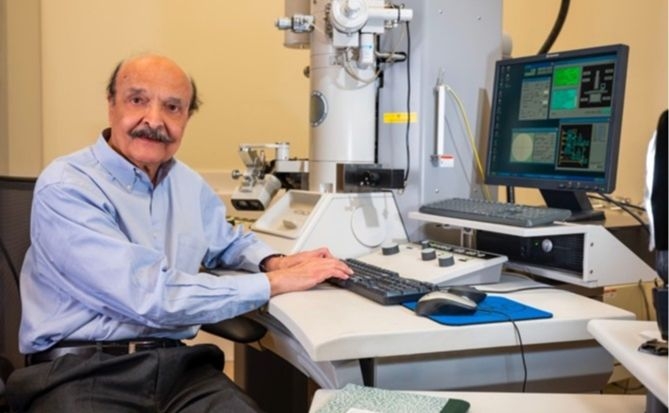News

Interview series with RILEM prominent members: Prof. Surendra P. Shah
Prof. Dr. Surendra P. Shah is Presidential Distinguished Professor, Civil Engineering, Materials Science and Engineering; Director, Center for Advanced Construction Materials, University of Texas at Arlington; and Walter P. Murphy Professor of Civil Engineering (emeritus in service), Northwestern University, USA. Prof. Shah was awarded the Robert L’Hermite medal in 1980; he became RILEM Fellow in 1994 and RILEM Honorary member in 2010. From 2001 to 2005 he served as member of Bureau. Prof. Shah chaired the following RILEM TCs: 048-FC “Testing of ferrocement”, 089-FMT “Fractures mechanics of concrete -Test methods”, and 148-SSC “Test methods for the strain softening response of concrete”. He is currently a member of TC CNC: “Carbon based nanomaterials for multifunctional cementitious matrices”.
2 March 2022
RILEM Implementation Manager (RIM): Thank you for joining me today! How are you, Prof. Shah?
Prof. Shah: Very well, thank you!
RIM: I know I am talking to a super-star, and I am very thrilled! You have an amazing career and an extensive CV. Let’s start from RILEM! You have been TC chair of a couple of TCs, member of many TCs, Robert L’Hermite medallist in 1980, RILEM Fellow in 1994 and RILEM Honorary member in 2010.
Prof. Shah: Yes, that’s correct!
RIM: When did everything start?
Prof. Shah: I remember that my first connection in RILEM was in the sixties when RILEM had organised a conference in Mexico City, I think it was in 1966 (Editor’s note: RILEM Symposium on effect of repeated loads on materials and structures). I was very excited to go. It was a very informative meeting. Then, I do not remember in which year exactly, it must have been sometimes in the seventies, that I was appointed as a chair of RILEM committee of Ferrocement. My interest in Ferrocement started when I had spent one year at the MIT along with Dr. Antoine E. Naaman. Together we did the first work on engineering aspects of ferrocement. As you might know, ferrocement was promoted by Pier Luigi Nervi. He had the intuition, but we gave some scientific basis, and we published several papers on this aspect (Editor’s note: the first one was “Tensile Strength of Ferrocement,” Journal, ACI, September 1971). I was then asked to chair a RILEM TC on ferrocement (Editor’s note: TC 048-FC: Testing of ferrocement). We organised the First International Symposium on Ferrocement in Bergamo, Italy (Editor’s note: “Ferro-1: Proceedings of RILEM International Symposium on Ferrocement”, Bergamo, Italy, Edited by G. Oberti, and S.P. Shah, Published by ISMES Bergamo, Italy, July 1981). The son of Pier Luigi Nervi attended that symposium. Subsequently many international symposiums have been organised periodically (Editor’s note: the 13th edition was organised in 2021). The concept of ferrocement is not so far away from that of textile reinforcement, which has been the topic of RILEM TCs. Then I chaired a second TC, 089-FMT: Fractures mechanics of concrete - Test methods, co-chaired with Prof. Alberto Carpinteri, from 1986 to 1992. We made highly cited recommendations through that committee. It was a very productive committee!
RIM: I found in your CV that you were also the Chairman of RILEM Technical Committee 148-SSC: Test methods for the strain softening response of concrete.
Prof. Shah: Correct, I co-chaired that TC with Prof. Jan G. M. van Mier.
RIM: I know that you are also an Honorary Member of ACI, and also fellow of the most prestigious engineering academies around the world. What has RILEM represented in your career?
Prof. Shah: RILEM has been very important to me! Let me tell an anecdote about me and RILEM. As you mentioned before, I was awarded the Robert L’Hermite medal in 1980. I was obviously very honoured to attend the award ceremony and I thought I had to deliver my presentation in French. So, every week I took lessons in French. I wrote my presentation in English and I asked my teacher to translate in French. I practiced my pronunciation. I travelled to Switzerland to receive the medal and give my speech and people were so impressed! At that time Maurice Fickelson was the RILEM General Secretary and he kept sending me papers to review which were written in French! I was lucky enough to have French students at that time who could help me. But that meeting was also very important because the same L’Hermite was there. It was his last meeting! Going back to your original question, it is true that I am also very active in ACI, but RILEM and ACI have somehow different characters. ACI recommendations often become a code that is followed in USA and other countries. ACI has also a good balance between academia, research and industry. On the other hand, I think ACI is more related to engineering applications while RILEM is more science based. What RILEM does is synthesizing and promoting knowledge. When I was a member of the management committee of RILEM, we tried to get industry involved but we were not very successful. I also tried a few times to have ACI and RILEM working together at the technical committee level.
RIM: Where were you and which role did you have in 1980, when you received the L’Hermite medal?
Prof. Shah: I was a professor at the University of Illinois in Chicago.
RIM: I had a look at some of the most cited papers from your list of publications. Some of this have been cited more than 1000 times (Current Google scholar citation index: 53119, h-index: 125)! I also checked your papers in Materials and Structures. I noticed that you started to publish in this journal in 1971 (Editor’s note: Gjorv, O.E., Shah, S.P. Testing methods for concrete durability. Mat. Constr. 4, 295–304 (1971)).
Prof. Shah: Unfortunately, Prof. Gjorv passed away. He was a professor in Norway. I was a visiting professor at MIT and Prof. Gjorv was at the MIT as a visiting scholar. At that time, we both were very intrigued with the so-called scanning electro-microscope. That was one of the first papers using this technology.
RIM: I also looked for the most impactful of your papers on Materials and Structures. I found Shah, S.P. Determination of fracture parameters (K sIc and CTODc) of plain concrete using three-point bend tests. Materials and Structures 23, 457–460 (1990), cited 211 times.
Prof. Shah: That publication came out from the RILEM committee 089-FMT: Fractures mechanics of concrete - Test methods.
RIM: I also found Shah, S.P. Size-effect method for determining fracture energy and process zone size of concrete. Materials and Structures 23, 461 (1990), Aldea, C.M., Shah, S.P. & Karr, A. Permeability of cracked concrete. Mat. Struct. 32, 370–376 (1999) and van Mier, J.G.M., Shah, S.P., Arnaud, M. et al. Strain-softening of concrete in uniaxial compression Report of the Round Robin Test carried out by RILEM TC 148-SSC. Mat. Struct. 30, 195–209 (1997). This last one was cited 147 times.
Prof. Shah: This last paper was the outcome of TC 148-SSC that I co-chaired with Prof. van Mier.
RIM: Was it “fun” to work in these committees?
Prof. Shah: Yes! You meet people from all over the world, you deliberate about interesting topics, it was a very good experience. I would like to add something else. When I joined RILEM, very early on, you can say that it was primarily a “good old men’s association”. These were people that were heads of big laboratories on testing materials. They were the ones organizing the RILEM meetings. There was a lot of administrative work but not enough TC meetings and not many conferences or symposia associated to the Annual week. It was very difficult for young people to attend. I pushed for a change, and I organized at the Northwestern University a Spring meeting that was connected with a Symposium (Editor’s note: Title: First International RILEM Symposium on Advances in Concrete Through Science and Engineering, organized by the Center for Advanced Cement Based Materials (ACBM) at Northwestern University and RILEM in Evanston, Illinois, on March 21-24, 2004,) so that young delegates could present their work and have funds from their university to do so. I also collaborated with Peter Richner, at the time he was RILEM President, to have Materials and Structures run by Springer. I am very happy I was associated with that transition.
RIM: Would you say RILEM was the main channel to communicate your results in concrete fracture, or it was one of many more media that you used to disseminate your research outcomes?
Prof. Shah: The impact of that research was due to the endorsement of the RILEM committee TC 089-FMT: Fractures mechanics of concrete - Test methods, so certainly RILEM was quite influential! There were other committees in which I was very much involved and one of them was 218-SFC : Sonic methods for quality control of fresh cementitious materials . Some very useful and impacting publications came out of that TC chaired by Prof. Hans W. REINHARDT. Also TC 162-TDF : Test and design methods for steel fibre reinforced concrete was a very productive committee!
RIM: You have recently given a presentation at the 75th RIELM Annual Week - International Conference on Advances in Sustainable Construction Materials and Structures in Mexico, titled "Sustainability with Graphene Based Composites". How was Merida?
Prof. Shah: It was a very good conference! Unfortunately, due to COVID, not many people attended in person, but I enjoyed it very much.
RIM: What makes you such an active person?
Prof. Shah: Curiosity! Being interested. I learn so much by working with students. I am committed to travelling at least once a year to IIT Madras, India, where I interact with students and faculties there. I am a Distinguish Professor at IIT Madras as well as at Jinan University, China. In addition, I am a member of Institute of Advanced Studies at Hong Kong University of Science and Technology and Honorary Professor at Hong Kong Polytechnic University. My interaction with these universities is intellectually very stimulating.














No comment
Log in to post comment. Log in.